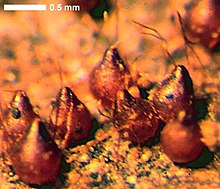Ascocarp
This article needs additional citations for verification. (October 2014) |
An ascocarp, or ascoma (pl.: ascomata), is the fruiting body (
Classification
The ascocarp is classified according to its placement (in ways not fundamental to the basic
Apothecium

An apothecium (plural: apothecia) is a wide, open, saucer-shaped or cup-shaped fruit body. It is sessile and fleshy. The structure of the apothecium chiefly consists of three parts: are similar.
Cleistothecium
A cleistothecium (plural: cleistothecia) is a globose, completely closed fruit body with no special opening to the outside. The ascomatal wall is called
Gymnothecium
Similar to a cleistothecium, a gymnothecium is a completely enclosed structure containing globose or pear-shaped, deliquescent asci. However, unlike the cleistothecium, the peridial wall of a gymnothecium consists of a loosely woven "tuft" of hyphae, often ornamented with elaborate coils or spines. Examples are the Gymnoascus, Talaromyces and the dermatophyte Arthroderma.
Perithecium

Perithecia are flask shaped structures opening by a pore or
Sometimes the perithecia are "free" (individually visible from the outside), but in many species they are embedded in a dense sterile tissue of haploid cells called a stroma (plural: stromata).[3]
Pseudothecium
This is similar to a perithecium, but the asci are not regularly organised into a hymenium and they are
See also
References
- ^ "ascocarp (fruiting structure of fungi)". Encyclopædia Britannica. Retrieved 23 November 2020.
- ^ "Atlas of Clinical Fungi (glossary)". Westerdijk Fungal Biodiversity Institute. Archived from the original on 28 October 2019. Retrieved 11 September 2019.
- ISBN 9780691180373.





